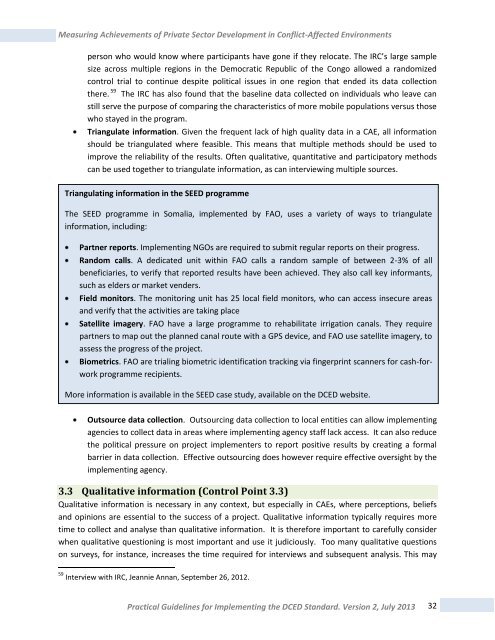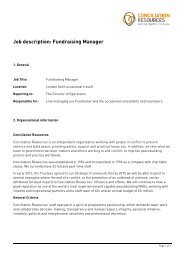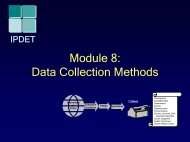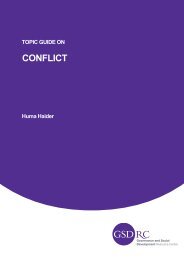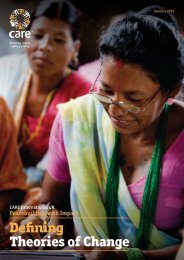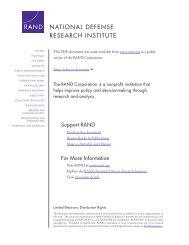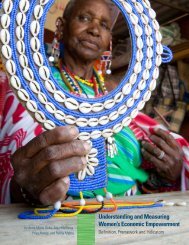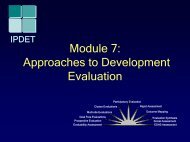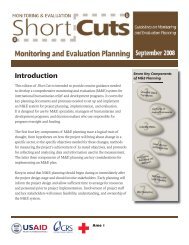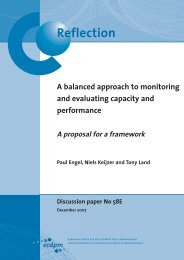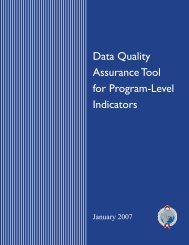Measuring Achievements of Private Sector Development in ... - DCED
Measuring Achievements of Private Sector Development in ... - DCED
Measuring Achievements of Private Sector Development in ... - DCED
You also want an ePaper? Increase the reach of your titles
YUMPU automatically turns print PDFs into web optimized ePapers that Google loves.
<strong>Measur<strong>in</strong>g</strong> <strong>Achievements</strong> <strong>of</strong> <strong>Private</strong> <strong>Sector</strong> <strong>Development</strong> <strong>in</strong> Conflict-Affected Environments<br />
person who would know where participants have gone if they relocate. The IRC’s large sample<br />
size across multiple regions <strong>in</strong> the Democratic Republic <strong>of</strong> the Congo allowed a randomized<br />
control trial to cont<strong>in</strong>ue despite political issues <strong>in</strong> one region that ended its data collection<br />
there. 59 The IRC has also found that the basel<strong>in</strong>e data collected on <strong>in</strong>dividuals who leave can<br />
still serve the purpose <strong>of</strong> compar<strong>in</strong>g the characteristics <strong>of</strong> more mobile populations versus those<br />
who stayed <strong>in</strong> the program.<br />
Triangulate <strong>in</strong>formation. Given the frequent lack <strong>of</strong> high quality data <strong>in</strong> a CAE, all <strong>in</strong>formation<br />
should be triangulated where feasible. This means that multiple methods should be used to<br />
improve the reliability <strong>of</strong> the results. Often qualitative, quantitative and participatory methods<br />
can be used together to triangulate <strong>in</strong>formation, as can <strong>in</strong>terview<strong>in</strong>g multiple sources.<br />
Triangulat<strong>in</strong>g <strong>in</strong>formation <strong>in</strong> the SEED programme<br />
The SEED programme <strong>in</strong> Somalia, implemented by FAO, uses a variety <strong>of</strong> ways to triangulate<br />
<strong>in</strong>formation, <strong>in</strong>clud<strong>in</strong>g:<br />
Partner reports. Implement<strong>in</strong>g NGOs are required to submit regular reports on their progress.<br />
Random calls. A dedicated unit with<strong>in</strong> FAO calls a random sample <strong>of</strong> between 2-3% <strong>of</strong> all<br />
beneficiaries, to verify that reported results have been achieved. They also call key <strong>in</strong>formants,<br />
such as elders or market venders.<br />
Field monitors. The monitor<strong>in</strong>g unit has 25 local field monitors, who can access <strong>in</strong>secure areas<br />
and verify that the activities are tak<strong>in</strong>g place<br />
Satellite imagery. FAO have a large programme to rehabilitate irrigation canals. They require<br />
partners to map out the planned canal route with a GPS device, and FAO use satellite imagery, to<br />
assess the progress <strong>of</strong> the project.<br />
Biometrics. FAO are trial<strong>in</strong>g biometric identification track<strong>in</strong>g via f<strong>in</strong>gerpr<strong>in</strong>t scanners for cash-forwork<br />
programme recipients.<br />
More <strong>in</strong>formation is available <strong>in</strong> the SEED case study, available on the <strong>DCED</strong> website.<br />
Outsource data collection. Outsourc<strong>in</strong>g data collection to local entities can allow implement<strong>in</strong>g<br />
agencies to collect data <strong>in</strong> areas where implement<strong>in</strong>g agency staff lack access. It can also reduce<br />
the political pressure on project implementers to report positive results by creat<strong>in</strong>g a formal<br />
barrier <strong>in</strong> data collection. Effective outsourc<strong>in</strong>g does however require effective oversight by the<br />
implement<strong>in</strong>g agency.<br />
3.3 Qualitative <strong>in</strong>formation (Control Po<strong>in</strong>t 3.3)<br />
Qualitative <strong>in</strong>formation is necessary <strong>in</strong> any context, but especially <strong>in</strong> CAEs, where perceptions, beliefs<br />
and op<strong>in</strong>ions are essential to the success <strong>of</strong> a project. Qualitative <strong>in</strong>formation typically requires more<br />
time to collect and analyse than qualitative <strong>in</strong>formation. It is therefore important to carefully consider<br />
when qualitative question<strong>in</strong>g is most important and use it judiciously. Too many qualitative questions<br />
on surveys, for <strong>in</strong>stance, <strong>in</strong>creases the time required for <strong>in</strong>terviews and subsequent analysis. This may<br />
59 Interview with IRC, Jeannie Annan, September 26, 2012.<br />
Practical Guidel<strong>in</strong>es for Implement<strong>in</strong>g the <strong>DCED</strong> Standard. Version 2, July 2013<br />
32


